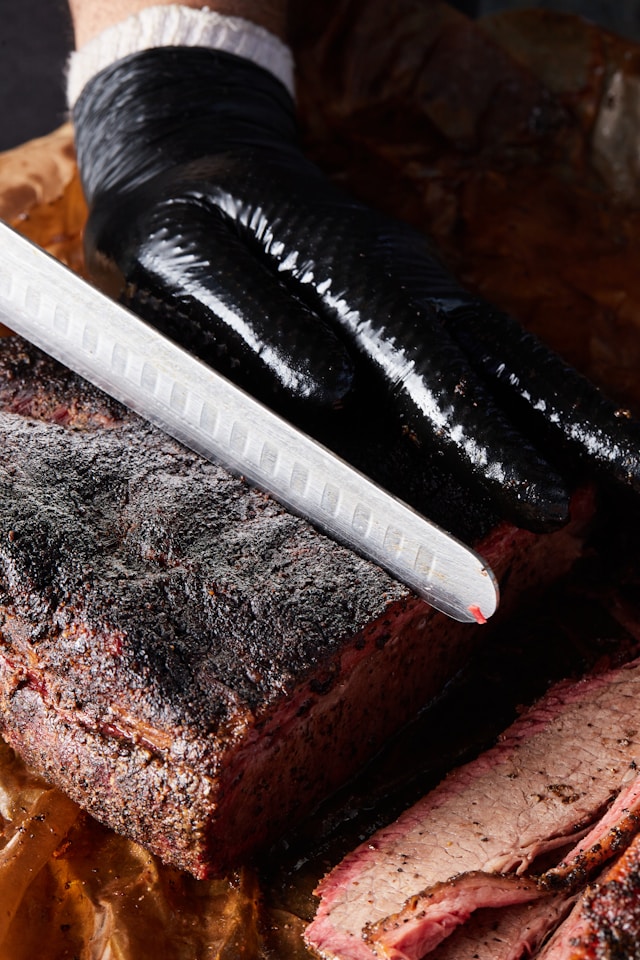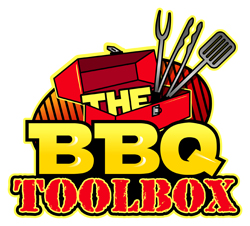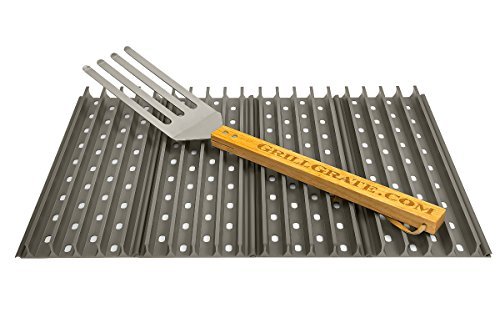

This guide will equip you with all the information you need to find the perfect brisket slicing knife! Whether you’re a seasoned pitmaster or a grill enthusiast venturing into brisket territory for the first time, having the right tool for the job is essential. Slicing a perfectly cooked brisket requires precision and control, and a well-chosen knife can make all the difference.
Table of Contents
ToggleQualities of the Best Brisket Slicing Knives
Blade Length
Aim for a long blade, typically ranging from 10 to 14 inches, for effortless cuts through large briskets. Brisket slicing knives prioritize blade length for a few key reasons:
- Effortless Slicing Through Large Cuts: Briskets are substantial
cuts of meat, often weighing 10-18 pounds. A longer blade (typically 10-14
inches) allows you to slice the entire brisket in one smooth motion rather than
needing to saw back and forth with a shorter blade. This minimizes tearing and
ensures clean, even slices. - Control and Precision: The additional length provides better leverage and control over the knife. This is especially important for maintaining a consistent slicing direction, particularly when cutting against the grain for maximum tenderness.
- Minimizing Fatigue: When using a shorter blade, you might need to use a sawing motion to cut through the entire brisket. This can lead to fatigue, especially when dealing with a large piece of meat. A longer blade allows for cleaner, single strokes, minimizing effort and reducing fatigue during long slicing sessions.
- Safety: A longer blade allows you to keep your hand further away from the cutting board while still maintaining control of the knife. This helps to prevent accidental cuts during the slicing process.
Here’s an analogy: Imagine trying to cut a long loaf of bread with a butter knife versus a bread knife. The longer blade of the bread knife allows for clean, effortless slicing, whereas the shorter butter knife would require more sawing and could result in tearing the bread. The same principle applies to brisket slicing knives.
While a shorter blade might be sufficient for some tasks, a longer blade offers significant advantages for effortless, precise, and safe slicing of large briskets.
Key Takeaways
Longer blade lengths of 12-14 inches will make the job of brisket slicing easier, more precise, and safer.
Blade Design
- Granton Edge (Scalloped Edge): Small indentations reduce friction and prevent sticking, allowing for cleaner cuts.
- Serrated Edge (Less Common): May be easier to maintain but can tear the meat more.
Brisket slicing knives come in two main blade edge types: granton and serrated. Here’s a breakdown of the pros and cons of each to help you decide which might be better for you:
Granton Edge (Scalloped Edge)

Pros:
- Reduced Friction: The small indentations or scallops along the blade create air pockets that help reduce friction as you slice. This prevents meat from sticking to the blade, allowing for cleaner cuts with minimal tearing.
- Maintains Sharpness: Granton edges tend to stay sharper for longer because they come into less contact with the meat during each slice.
- Versatility: While ideal for brisket, granton edges work well for slicing other cooked meats and some vegetables.
Cons:
- Less Aggressive Cutting: Granton edges are not as aggressive as serrated blades, and may require slightly more force to cut through particularly tough areas of meat.
- Maintenance: While still easier than serrated blades, sharpening a granton edge requires navigating the indentations, which might be more challenging for some home cooks.
Serrated Edge

Pros:
- Effortless Slicing: The serrated teeth grip and tear through the meat, requiring minimal force even for tough cuts. This can be helpful for those with weaker hand strength.
- Ease of Maintenance: Serrated edges generally hold their edge for a longer period and require less frequent sharpening compared to granton or plain edges.
Cons:
- Tearing: The aggressive cutting action of serrated blades can tear the meat more than a granton or plain edge, especially on softer cuts. This can affect the aesthetics and texture of the sliced meat.
- Limited Versatility: Serrated blades are primarily suited for slicing cooked meats and not ideal for other cutting tasks.
- Sharpening Difficulty: Sharpening serrated blades requires specialized tools or a professional sharpener, making it more challenging for home cooks.

Choosing the right blade edge
- Focus on Clean Cuts: If clean, tear-free slices are your top priority, a granton edge is generally the better choice.
- Ease of Use and Maintenance: If you prioritize ease of use and require minimal sharpening, a serrated edge might be a good option. However, be aware of potential tearing.
- Versatility: If you plan to use the knife for tasks beyond slicing brisket, a granton edge offers more flexibility.
Additional Considerations
- Your Knife Skills: If you have good knife skills and can maintain a clean, sawing motion, a granton edge might be sufficient.
- Meat Quality: For particularly tough cuts of meat, a serrated edge might offer an advantage.
Key Takeaways
Granton edge blades are best for clean cuts with little tearing of the meat. Serrated edge blades are easier to maintain, but since BBQ brisket is so tender, it will produce more tearing when slicing a brisket.
Blade Material
When it comes to brisket slicing knives, the key material considerations lie in the blade. High-carbon stainless steel and Japanese steel are popular choices for their exceptional sharpness, ensuring clean cuts and effortless slicing. These materials also boast good durability and resist rust, making them easy to maintain. The best blade material for you depends on your budget and priorities. If you value peak sharpness, Japanese steel might be the way to go. If you prioritize a balance of sharpness, durability, and affordability, high-carbon stainless steel could be a great option.
Sharpness and Clean Cuts:
- Strong Materials: High-carbon stainless steel and Japanese steel are known for their strength and ability to retain a sharp edge for extended periods. This means you won’t need to sharpen the knife as frequently, saving time and effort.
- Long-lasting Performance: A durable blade ensures the knife maintains its peak performance over time, delivering consistent results for numerous briskets.
Durability and Edge Retention:
- High-Quality Materials: Brisket slicing knives typically use high-carbon stainless steel or Japanese steel. These materials hold a sharp edge exceptionally well, allowing for clean, thin slices that maintain the tenderness of the meat. Dull blades tear and shred the meat, resulting in an unpleasant texture.
- Effortless Slicing: A sharp knife glides effortlessly through the brisket, requiring minimal force. This reduces user fatigue and makes the slicing process more efficient and enjoyable.
Additional Benefits:
- Rust Resistance: High-quality stainless steel offers superior rust resistance, making the knife easier to maintain and reducing the risk of damage.
- Ease of Sharpening: While all knives eventually need sharpening, some blade materials are easier to sharpen at home with a honing rod or sharpener.
Here's a table summarizing the benefits of high-quality blade materials:
| Benefit | Description |
|---|---|
| Sharpness | Allows for clean, thin slices and maintains meat tenderness. |
| Effortless Slicing | Requires minimal force, reducing fatigue. |
| Durability | Retains a sharp edge for extended periods. |
| Long-lasting Performance | Ensures consistent results over time. |
| Rust Resistance | Easier to maintain and reduces the risk of damage. |
| Ease of Sharpening | Some materials are easier to sharpen at home. |
Remember: While high-carbon stainless steel and Japanese steel are popular choices, other materials like German steel can also offer good performance. The best blade material for you depends on your budget and preferences.
More on knife steel differences:
Here’s a breakdown of the key differences between high-carbon stainless steel, Japanese steel, and German steel used in knives:
Brisket Slicing Knife Steel Types
| Feature | High-Carbon Stainless Steel | Japanese Steel | German Steel |
|---|---|---|---|
| Carbon Content | High | Varies | Lower |
| Sharpness | Excellent | Exceptional | Good |
| Durability | Good balance of hardness and toughness, chip-resistant | Varies, some very hard, some prioritize sharpness | More flexible, chip-resistant |
| Ease of Sharpening | Moderately easy | More challenging | Easiest to sharpen |
| Examples | X50Cr15Mov (Chinese knives), AUS-10A (Japanese knives) | VG-10 (high-end Japanese knives), White Steel (very sharp, prone to chipping) | 1.4116 (German knives like Wüsthof), X50CrMoV15 (European/Chinese knives) |
Choosing the Right Steel
- Prioritize Sharpness: If achieving the absolute sharpest edge is your top concern, Japanese steel might be the best choice.
- Need for Durability: For tasks involving some force or where chipping is a concern, German steel offers a good balance.
- Budget: High-carbon stainless steel and some Japanese steels can be more affordable options.
Ultimately, the best steel type depends on your individual needs and priorities.
Key Takeaways
For perfect brisket slices, prioritize a knife with a high-quality blade like high-carbon stainless steel or Japanese steel. These materials ensure razor-sharpness for clean cuts, minimize effort while slicing, and stay sharp for extended use.
Other Considerations
Handle Comfort and Grip

Brisket slicing requires long strokes and control. To avoid fatigue and ensure safety, a brisket slicing knife needs a comfortable, non-slip handle. A well-designed handle allows for a firm grip, minimizing the risk of slipping and maximizing control for clean, effortless cuts.
Balance
A well-balanced brisket knife feels like an extension of your hand, reducing strain and fatigue. Even weight distribution throughout the knife allows for smooth, controlled strokes. This becomes especially important when maneuvering the long blade to achieve consistent, thin slices of brisket.
Brisket Slicing Knife FAQs
General Inquiries:
A brisket slicing knife is a long, sharp knife specifically designed to cut through large cuts of brisket with ease and precision.
Technically, you can slice brisket with any sharp knife. However, a brisket slicing knife offers several advantages, including a longer blade for effortless cuts, a granton edge to reduce friction and prevent sticking, and a comfortable handle for better control.
- Blade Length: Look for a blade around 10-14 inches long for smooth, single strokes through the entire brisket.
- Blade Material: High-carbon stainless steel or Japanese steel are popular choices for sharpness, durability, and rust resistance.
- Blade Edge: Granton edges with small indentations are common for clean cuts, while serrated edges might be easier to maintain but can tear the meat more.
- Handle Comfort and Grip: A well-shaped, non-slip handle ensures control and prevents accidents.
- Balance: Even weight distribution between the blade and handle minimizes fatigue during long slicing sessions.
Using a Brisket Slicing Knife:
There are several techniques for slicing brisket. Typically, you'll want to slice against the grain for maximum tenderness. Online resources and instructional videos can provide detailed guidance.
Wash your knife with warm soapy water after each use and dry it thoroughly. Honing your knife regularly helps maintain its edge, and periodic sharpening is necessary to restore its sharpness.
Serrated edges may require less force and can be easier to maintain, but they can also tear the meat more. Granton edges offer a good balance of ease of use and clean cuts.
Buying Advice:
Brisket slicing knives range in price from $25 to over $300. The price is influenced by factors like material, brand, and features. Weigh your budget and blade material selection to determine best fit for how much to spend.
Brisket slicing knives can be found at kitchenware stores, online retailers, and some specialty butcher shops.
Victorinox | |
Mercer Culinary | |
Dalstrong | |
Cutluxe | |
Dexter-Russell | |
Wüsthof | |
Shun | |
Mac | |
Zwilling J.A. Henckels | |
Misono | https://japanesechefsknife.com/collections/misono-ux10-series-pure-sweden-stainless-steel |
Brisket Slicing Knife Recommendations:
- Blade Length: 12-14 inches
- Blade Edge Design: Granton
- Blade Material: Japanese or German steel
- Handle Design: Ergonomic handle for firm grip and/or non slip grip material
Our Recommendations for brisket slicing knives based on our design and material criteria best suited for slicing tender briskets.
Brisket Slicing Knives Over $75
Feature | Dalstrong Gladiator Series Slicing & Carving Knife | Dalstrong Shogun Series Slicing & Carving Knife | Shun Classic Hollow Ground Slicing Knife |
Product Image |  |  |  |
Blade Length | 12 inch | 12 inch | 11 inch |
Blade Material | High-Carbon German Steel | Japanese AUS-10A Stainless Steel | VG-Max Stainless Steel |
Blade Edge Type | Granton | Granton | Granton |
Amazon Rating | 5/5 4.8/5 | 5/5 4.8/5 | 5/5 4.8/5 |
Price (on Amazon) |
Brisket Slicing Knives Under $75
Feature | SpitJack BBQ Smoked Brisket Knife | Cutluxe Slicing Carving Knife | Mercer Culinary Millennia Granton Edge Slicer | Victorinox Fibrox Pro Slicing Knife |
Product Image |  |  |  |  |
Blade Length | 11 inch | 12 inch | 11 inch | 12 inch |
Blade Material | Stainless Steel | High-Carbon German Steel | Japanese Steel | High-Carbon Stainless Steel |
Blade Edge Type | Granton | Granton | Granton | Granton |
Amazon Rating | 4.5/5 4.7/5 | 5/5 4.8/5 | 4.5/5 4.7/5 | 5/5 4.8/5 |
Price (on Amazon) |
Armed with this comprehensive guide, you’re now ready to confidently choose the perfect brisket slicing knife! Whether you prioritize clean cuts, ease of use, or a balance of both, this guide has equipped you with the knowledge to make an informed decision. Remember, the right knife can elevate your brisket experience from good to great. So, browse online retailers or visit your favorite kitchenware store today and find the perfect tool to transform your next perfectly smoked brisket into beautiful, tender slices!
For other BBQ Tool Options check out this post on 5 must have BBQ tools. Click Here


